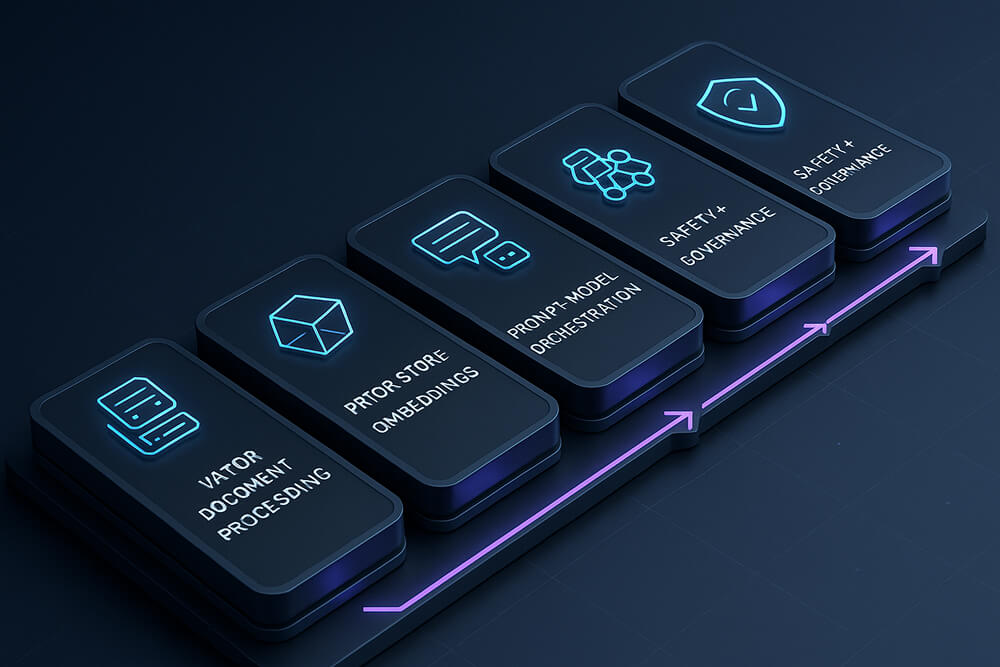
Generative AI is moving from demos to production, but the gap between a promising prototype and a reliable application is where projects often stall. LLMOps practices for large language models turn experiments into dependable, governed, and cost-efficient systems.
What is LLMOps?
LLMOps is the discipline of managing the end-to-end lifecycle of LLM applications, encompassing data preparation, prompt and retrieval design, evaluation, deployment, monitoring, and continuous improvement. It combines MLOps rigor with LLM-specific needs, such as prompt/version control, grounding via retrieval-augmented generation (RAG), safety filters, and human-in-the-loop review. In practice, a mature LLMOps platform centralizes these capabilities, allowing product teams to ship features without reinventing their pipelines.
A Reference Architecture for Production LLMs
To translate the definition into buildable parts, most teams converge on a modular architecture:
- Data and Features: Connectors, vector stores, and document processing for chunking, embeddings, and metadata policies.
- Experimentation: Prompt templates, few-shot libraries, parameter sweeps, and offline evaluation sets.
- Serving: API gateway, model router (open-source and hosted models), caching, and cost controls.
- Safety and Governance: PII redaction, toxicity filters, guardrails, and audit logs.
- Observability: Metrics, traces, evaluations, and feedback loops tied to tickets.
- Release Management: Versioned prompts, datasets, and evaluation reports attached to deployments.
This blueprint keeps concerns separated, allowing teams to swap LLMOP tools without tearing down the entire stack.
Practical Implementation Phases
With the architecture in mind, implementation usually flows through four phases that build on each other:
- Prototype with guardrails: Establish a minimal baseline prompt templates in version control, a staging vector store, and an API key vault. Add basic input/output filters and caching to mitigate latency and reduce costs.
- Evaluate before shipping: Create golden datasets that represent real user tasks; measure answer quality, hallucination, latency, and spend. Automate comparisons across models and prompts, and block deploys that regress.
- RAG hardening and routing: Productionize ingestion (chunking, deduping, embeddings), verify retrieval quality with recall/precision, and route requests across models by task, cost, or data sensitivity.
- Operate continuously: Add user feedback capture, incident runbooks, drift alerts for retrieval and prompts, and weekly evaluation jobs that gate releases.
Choosing the Right LLMOps Tools
Building on phased delivery, choose LLMOPs tools by capability rather than brand names:
- Prompt & Dataset Versioning: Treat prompts like code; require diffs, rollbacks, and links to evaluation runs.
- Evaluation & Observability: Offline test suites, online A/B tests, and tracing that shows which context chunks drove an answer.
- RAG Infrastructure: Robust document processing, embedding jobs, and scalable vector indices with metadata filtering and TTLs.
- Safety & Compliance: Configurable redaction, policy checks, and per-tenant auditability.
- Cost & Performance Controls: Caching, rate limits, and model selection policies (e.g., “draft on small model, escalate on uncertainty”).
- Integration Surfaces: SDKs, webhooks, and policy engines that fit the existing CI/CD.
Selecting an LLMPs platform against these criteria reduces switching costs as models and regulations evolve.
Operational Best Practices That Stick
Tooling works best when anchored in habits that connect to the previous selection criteria:
- Define “good” upfront: Write task-level rubrics and acceptance thresholds so evaluation is objective.
- Keep a living golden set: Refresh examples from real traffic and re-score after major data or model changes.
- Version everything: Prompts, retrieval chains, datasets, and guards are released together.
- Fail safely: Timeouts, deterministic fallbacks, and user-visible disclaimers for uncertain answers.
- Close the loop: Convert thumbs-up/down and editor fixes into labeled data for training and prompt updates.
- Cost hygiene: Monitor token burn per feature and per tenant, and alert on spikes and cache misses.
These LLMs’ best practices prevent drift and help teams scale features without scaling incidents.
Measuring What Matters
To keep improvements aligned with outcomes, connect metrics to product goals, including task success rate (both offline and online), groundedness/hallucination rate, latency at p95, cost per successful task, retrieval recall, and safety violation rate. Tie alerts to user impact and require evaluation reports to be included in release notes. Dashboards should allow owners to drill down from a poor metric to the exact prompt, model, and context that generated it.
Common Pitfalls and How to Avoid Them
Finally, many setbacks share common patterns: shipping without a golden set; treating RAG as a switch rather than a system that requires data quality work; chasing a model of the week without evaluation parity; storing prompts outside of version control; and ignoring cache behavior in cost forecasts. Bake defenses into the pipeline so these mistakes are hard to repeat.
Conclusion
Start with a modular architecture, adopt an evaluation-first development approach, and enforce versioned releases with clear guardrails. Then, scale by instrumentation: measure retrieval, quality, latency, and cost, and let those signals drive prompt, data, and model changes.

